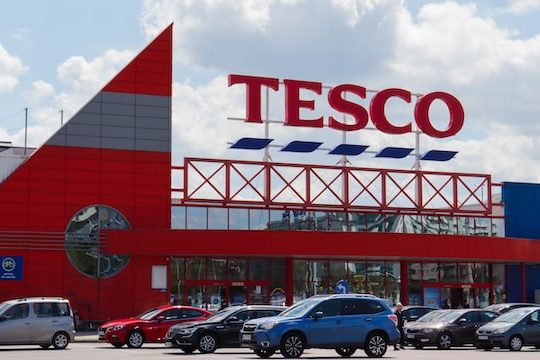Before we dive deep into the SWOT analysis, let’s get the business overview of Tesco. Tesco plc is a British multinational retail company specializing in the grocery and general merchandise sector. It was founded by Jack Cohen in 1919 and has grown to become one of the world’s largest retailers. Tesco operates across multiple countries, with its primary market being the United Kingdom. Here’s an overview of Tesco’s business:
- Market Position: Tesco is the UK’s leading supermarket, holding a significant market share in the country’s grocery sector. It also has a strong presence in other countries, including Ireland, Central Europe, and Asia.
- Store Formats: Tesco operates various store formats to cater to different customer needs, including Extra, Superstore, Metro, Express, and One Stop. These formats range from large hypermarkets to smaller convenience stores.
- Product Range: The retailer offers a broad range of products, including groceries, clothing, household items, and electronics. It also has a robust private label offering through its exclusive brands, such as Tesco Finest, Tesco Everyday Value, and F&F.
- Online Presence: Tesco’s robust online platform allows customers to order groceries and other products through its website and mobile app. The company offers home delivery and click-and-collect services to provide convenience to its customers.
- Loyalty Program: Clubcard, Tesco’s loyalty program, rewards customers with points for their purchases, which can be redeemed for discounts, vouchers, or other benefits. This program helps Tesco maintain customer loyalty and gather valuable consumer data.
- Corporate Social Responsibility: Tesco has implemented various sustainability initiatives, including reducing food waste, minimizing plastic usage, and sourcing products ethically. It aims to become a zero-carbon business by 2050.
- Financial Performance: Tesco has demonstrated strong financial performance, consistent revenue, and profit growth. The company focuses on cost-saving measures and operational efficiency to maintain its profitability.
- Acquisitions and Partnerships: Tesco has pursued strategic acquisitions and partnerships to expand its market reach and diversify its business. Notable acquisitions include the UK food wholesaler Booker Group and the convenience store chain One Stop.
In its 2023/2024 financial year, Tesco’s annual revenue amounted to more than 61.5 billion British pounds in the United Kingdom and the Republic of Ireland.
TESCO – British Retailer that redefined Grocery Shopping
Here is the PESTEL analysis of Tesco
A PESTEL analysis is a strategic management framework used to examine the external macro-environmental factors that can impact an organization or industry. The acronym PESTEL stands for:
- Political factors: Relate to government policies, regulations, political stability, and other political forces that may impact the business environment.
- Economic factors: Deal with economic conditions and trends affecting an organization’s operations, profitability, and growth.
- Sociocultural factors: Relate to social and cultural aspects that may influence consumer preferences, lifestyles, demographics, and market trends.
- Technological factors: Deal with developing and applying new technologies, innovations, and trends that can impact an industry or organization.
- Environmental factors: Relate to ecological and environmental concerns that may affect an organization’s operations and decision-making.
- Legal factors: Refer to the laws and regulations that govern businesses and industries.
In this article, we will do a PESTEL Analysis of Tesco.
PESTEL Analysis Framework: Explained with Examples
Political
- Government policies and regulations: Tesco operates in various countries, and each government’s policies and regulations can significantly impact its operations. Changes in taxation, import/export regulations, consumer protection laws, and labor laws can affect the company’s costs, supply chain, and overall performance.
- Political stability: Political stability in the countries where Tesco operates is essential for its long-term success. Political unrest or instability may lead to disruptions in supply chains, increased risk of theft or damage to stores, and fluctuations in currency exchange rates, which can negatively impact the company’s profitability.
- Trade agreements and tariffs: Tesco’s international operations and supply chain rely on global trade. Changes in trade agreements, such as the UK’s exit from the European Union (Brexit), can create challenges in terms of tariffs, import/export restrictions, and regulatory compliance. Adapting to these changes can be costly and time-consuming.
- Lobbying and public relations: Tesco actively engages with governments and policymakers to shape regulations and policies that favor its business interests. The company’s lobbying efforts may help it secure favorable policies, gain competitive advantages, or mitigate potential risks.
- Ethical and sustainability concerns: Governments increasingly promote ethical and sustainable business practices through policies, regulations, and incentives. Tesco’s ability to demonstrate commitment to social and environmental responsibility can impact its reputation, customer loyalty, and access to public funding or subsidies.
- Geopolitical tensions: Global political tensions can affect Tesco’s supply chain and overall business operations. For instance, trade wars or diplomatic disputes may lead to restricted access to certain markets or increased costs due to tariffs and other barriers.
Economic
- Economic growth: The economic growth of countries where Tesco operates directly affects consumer purchasing power and spending habits. A strong economy typically results in higher consumer spending, which benefits retailers like Tesco. Conversely, consumer spending will likely decrease during economic downturns or recessions, affecting Tesco’s sales and profitability.
- Inflation and interest rates: Inflation and interest rates influence Tesco’s costs, pricing strategies, and consumer behavior. High inflation can lead to increased costs for goods and services, which may force Tesco to raise its prices. Additionally, high-interest rates can affect consumer borrowing and spending habits, potentially leading to reduced sales for the company.
- Unemployment rates: Unemployment rates in the countries where Tesco operates can impact consumer spending and the availability of skilled labor. High unemployment rates may result in decreased consumer spending, while low unemployment rates can make it more challenging for Tesco to recruit and retain qualified employees at competitive wage rates.
- Exchange rates: As a multinational company, Tesco deals with multiple currencies and is exposed to fluctuations in exchange rates. These fluctuations can impact the company’s costs, profitability, and pricing strategies. For instance, a weaker British pound may make imported goods more expensive, while a stronger pound can increase Tesco’s purchasing power in international markets.
- Consumer confidence and preferences: Consumer confidence and preferences are influenced by various economic factors, such as income levels, job security, and overall economic outlook. Changes in consumer preferences or a decline in consumer confidence can lead to reduced sales or necessitate changes in Tesco’s product offerings and marketing strategies.
- Government fiscal and monetary policies: Government policies, such as changes in taxation, subsidies, or monetary policies, can directly affect Tesco’s operations. For example, changes in value-added tax (VAT) or corporate tax rates can impact the company’s profitability, while changes in monetary policy can influence interest rates and inflation.
Sociocultural
- Demographic trends: Population size, age distribution, and household structure changes can affect consumer preferences and demand for different products and services. For example, an aging population may increase demand for health-related products, while a growing number of single-person households might increase the demand for smaller or single-serving products.
- Health and wellness awareness: As consumers become more health-conscious, their preferences for organic, low-calorie, and low-fat products are growing. Tesco needs to adapt its product offerings and marketing strategies to cater to this shift in consumer preferences and capitalize on the health and wellness trend.
- Ethical and sustainable consumption: An increasing number of consumers are becoming concerned about their purchasing decisions’ ethical and environmental implications. Tesco must ensure that its sourcing practices, supply chain, and product offerings align with these values by promoting fair trade, sustainable production methods, and environmentally friendly packaging.
- Cultural diversity: As Tesco operates in various countries with different cultural backgrounds, it needs to be sensitive to local customs, tastes, and preferences. This may involve offering products that cater to specific dietary requirements or religious beliefs and adapting marketing campaigns to resonate with local audiences.
- Lifestyle changes: Changes in consumer lifestyles, such as the rise of remote working, increased focus on convenience, and growth in online shopping, can influence the types of products and services consumers demand. Tesco must continuously adapt its product offerings, store formats, and online presence to cater to these changing consumer needs.
- Social attitudes and values: Social attitudes and values influence consumer behavior and preferences. For example, increasing gender equality, concern for animal welfare, and support for local businesses can all affect the demand for specific products and services. Tesco must be aware of these trends and adapt its strategies accordingly to maintain customer loyalty and satisfaction.
Technological
- E-commerce and digitalization: The rapid growth of e-commerce has transformed the retail landscape, making it crucial for Tesco to invest in its online presence and digital capabilities. This includes improving its website and mobile app, optimizing the online shopping experience, and leveraging data analytics to understand customer preferences and personalize marketing campaigns.
- Supply chain management and logistics: Technological advancements in supply chain management and logistics can help Tesco streamline its operations, reduce costs, and ensure the timely delivery of products. This includes warehouse automation, advanced inventory management systems, and GPS tracking for transportation and delivery.
- Electronic payment systems: As more consumers adopt digital and contactless payment methods, Tesco needs to ensure that it supports a wide range of secure and convenient payment options in-store and online. This includes integrating mobile wallets, contactless card payments, and other emerging payment technologies.
- Artificial intelligence (AI) and machine learning: AI and machine learning can help Tesco optimize various aspects of its business, from predicting customer preferences and personalizing marketing campaigns to automating customer service through chatbots. Investing in these technologies can improve efficiency and enhance the overall customer experience.
- Internet of Things (IoT) and smart technologies: IoT and smart technologies can be used in various applications within Tesco’s operations, such as smart shelves to monitor inventory levels, connected devices for energy management, and smart shopping carts for a seamless in-store experience. Embracing these technologies can help Tesco reduce costs and improve customer satisfaction.
- Sustainability technologies: As environmental concerns become increasingly important, Tesco should invest in sustainable technologies to reduce environmental impact. This may include energy-efficient store designs, renewable energy systems, waste reduction technologies, and environmentally friendly packaging solutions.
Environmental
- Climate change: Climate change can affect Tesco’s operations and supply chain by causing extreme weather events, disrupting agricultural production, and increasing the frequency of natural disasters. Tesco needs to implement measures to mitigate these risks, such as diversifying suppliers, investing in climate-resilient infrastructure, and reducing its greenhouse gas emissions.
- Waste management and recycling: As a major retailer, Tesco generates significant amounts of waste, including packaging, food, and other materials. The company must develop and implement effective waste management and recycling policies to minimize its environmental impact, comply with regulations, and meet consumer expectations for sustainable practices.
- Energy consumption and efficiency: Tesco’s stores, warehouses, and transportation network consume substantial amounts of energy. Investing in energy-efficient technologies and practices, such as LED lighting, energy management systems, and renewable energy sources, can help the company reduce its energy consumption, lower its carbon footprint, and cut operational costs.
- Water management: Water scarcity and pollution are growing global concerns, and Tesco needs to ensure that its operations and supply chain do not contribute to these issues. This includes implementing water-saving measures, such as efficient irrigation systems and water recycling, and working with suppliers to promote sustainable water management practices.
- Biodiversity and ecosystem preservation: Tesco’s sourcing and land-use practices can impact biodiversity and ecosystems. The company should work with suppliers to promote responsible sourcing, reduce deforestation, and protect endangered species and habitats.
- Environmental regulations and standards: Tesco must comply with various environmental regulations and standards locally and internationally. This includes meeting emission targets, adhering to waste management regulations, and obtaining relevant certifications, such as ISO 14001 for environmental management systems.
- Consumer expectations for sustainability: As consumers become more environmentally conscious, they increasingly expect companies to prioritize sustainability. Tesco must demonstrate its commitment to environmental responsibility through transparent reporting, ambitious sustainability targets, and eco-friendly product offerings.
Legal
- Employment and labor laws: Tesco must adhere to employment and labor laws in its operating countries. This includes compliance with minimum wage regulations, working hours, health and safety standards, equal opportunities, and anti-discrimination laws. Failure to comply with these laws can result in fines, legal disputes, and reputational damage.
- Consumer protection laws: As a retailer, Tesco must comply with consumer protection laws, which cover product safety, quality, and labeling standards, as well as data protection and privacy regulations. Ensuring its products and services meet these legal requirements is essential for maintaining customer trust and avoiding penalties or legal actions.
- Taxation and customs laws: Tesco must comply with various taxation and customs laws in the countries where it operates, including corporate tax rates, value-added tax (VAT), import/export duties, and transfer pricing regulations. Non-compliance with these laws can lead to financial penalties, legal disputes, and reputational damage.
- Competition and antitrust laws: Tesco must adhere to competition and antitrust laws, which aim to promote fair competition and prevent anti-competitive practices, such as price-fixing, market manipulation, or abuse of market power. Failure to comply with these laws can result in fines, legal sanctions, and damage to the company’s reputation.
- Environmental and sustainability regulations: Tesco is subject to various environmental and sustainability regulations, which govern emissions, waste management, recycling, and resource conservation. Compliance with these regulations is essential to avoid penalties, maintain a positive brand image, and meet consumer expectations for sustainable practices.
- Intellectual property (IP) laws: Tesco must protect its intellectual property, such as trademarks, patents, and copyrights, and ensure that it does not infringe on the IP rights of others. Failure to manage IP effectively can lead to legal disputes, financial penalties, and reputational damage.
- International trade laws and agreements: As a multinational company, Tesco is subject to international trade laws and agreements that govern cross-border transactions, tariffs, and import/export restrictions. Navigating these complex legal frameworks is crucial for ensuring smooth operations, managing costs, and maintaining good relations with trading partners.











